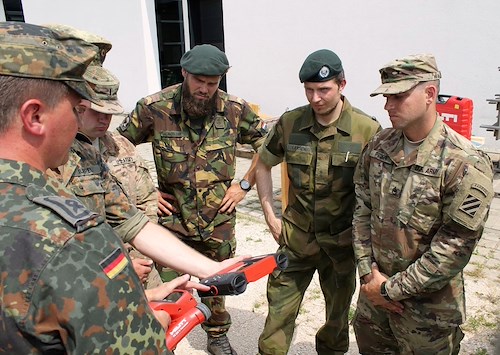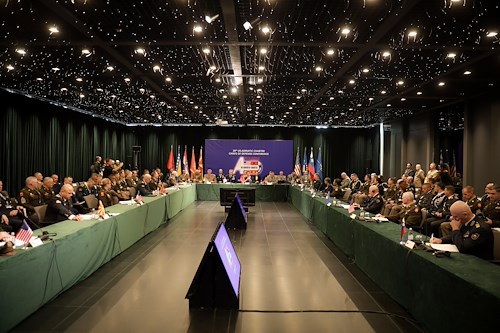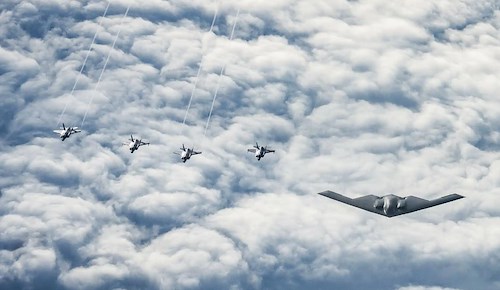Gallery contains 5 images
×
Photo 1 of 5
NATO Engineers share different bridge assessment methods
Staff Sgt. Craig Pruden, a combat engineer with 10th Engineer Battalion, 1st Armored Brigade Combat Team, 3rd Infantry Division, listens as German Soldiers talk about different equipment they use to assess bridges during a an International Bridge Assessment Course at Ingolstadt, Germany July 12. The course, a bilateral project from the Belgian and German engineer schools, supported by the Military Engineering Centre of Excellence, aims to inform Soldiers on the different existing bridge assessment methods.
Photo by: Maj. Randy Ready
Photo 2 of 5
NATO Engineers share different bridge assessment methods
U.S. Army 1st Lt. Graham Hill, an engineer with the 10th Engineer Battalion, 1st Armored Brigade Combat Team, 3rd Infantry Division, works with a German Soldier to assess a bridge near Ingolstadt, Germany July 14 as part of an International Bridge Assessment Course. The Soldiers used different bridge assessment methods and later compared the Military Load Classifications to see the difference in how each country assesses a bridge.
Photo by: Maj. Randy Ready
Photo 3 of 5
NATO Engineers share different bridge assessment methods
U.S. Army 1st Lt. Graham Hill, an engineer with the 10th Engineer Battalion, 1st Armored Brigade Combat Team, 3rd Infantry Division, helps a German Soldier get out of a creek as they assess a bridge near Ingolstadt, Germany July 14. Soldiers from the battalion joined engineers from 11 NATO countries and a Partner for Peace country for an International Bridge Assessment Course aimed at informing Soldiers on the different existing bridge assessment methods.
Photo by: Maj. Randy Ready
Photo 4 of 5
NATO Engineers share different bridge assessment methods
Staff Sgt. Kwayne Huggins, a combat engineer with 10th Engineer Battalion, 1st Armored Brigade Combat Team, 3rd Infantry Division, scans a bridge to locate and assess the steel reinforcement as part of a bridge assessment near Ingolstadt, Germany July 14. Soldiers from the battalion joined engineers from ten NATO countries for an International Bridge Assessment Course to inform Soldiers on the different existing bridge assessment methods.
Photo by: Maj. Randy Ready
Photo 5 of 5
NATO Engineers share different bridge assessment methods
U.S. Army 2nd Lt. Katelynn Clark (center), an assistant operations officer for the 10th Engineer Battalion, 1st Armored Brigade Combat Team, 3rd Infantry Division, listens as a Belgian officer talks about different equipment they use to assess bridges during a an International Bridge Assessment Course at Ingolstadt, Germany July 12. The course, a bilateral project from the Belgian and German engineer schools, supported by the Military Engineering Centre of Excellence, aims to inform Soldiers on the different existing bridge assessment methods.
Photo by: Maj. Randy Ready
GRAFENWOEHR, Germany – Soldiers from the 10th Engineer Battalion, 1st Armored Brigade Combat Team, 3rd Infantry Division joined Soldiers from 11 NATO countries and one Partner for Peace country for an International Bridge Assessment Course at Ingolstadt, Germany July 11.
The course, a bilateral project from the Belgian and German engineer schools, supported by the Military Engineering Centre of Excellence, aims to inform Soldiers on the different existing bridge assessment methods.
It was just the second time the 5-day course was offered.
“The course went over STANAG 2021 and showed us the different bridging operations that each country uses and how they assess bridges,” said 2nd Lt. Katelynn Clark, an assistant operations officer for the 10th Eng. Bn. “It’s really important to know how each country assesses everything, because if we have to go into their country, we need to know what they look at because it might affect whether or not our vehicle is going to successfully be able to cross that bridge.”
In NATO, a Standardization Agreement, or STANAG, defines processes and procedures for military or technical procedures to provide a common standard for all member nations.
STANAG 2021 standardizes a method of computing the Military Load Classification of bridges, ferries and vehicles. The MLC determines the weight a bridge will be able to safely support.
“The importance of an MLC is to let your commander know whether or not the vehicle they are trying to push over the bridge can [safely] cross,” said Clark, a Paris, Texas native. “If it can’t get over, what kind of support do we need to give this bridge so it can.”
The course started with presentations from six countries on how they assess a bridge followed by stations demonstrating some of the different equipment used to test the hardness of concrete or the density of steel. The Soldiers later went out and actually assessed a number of bridges using some of the different methods and comparing the MLCs.
“It was a good way to see how other nations assess bridges and which method may be the most effective,” said Staff Sgt. Craig Pruden, a combat engineer with Company A, 10th Eng. Bn. “The course provided a good understanding on how to do a bridge assessment and to see the correlation between them.”
Pruden, who hails from Prince William County, Virginia, said though there are similarities between each of the country’s assessment methods, the MLCs they produce can vary significantly. That is why, if the U.S. Army has to move equipment on another country’s infrastructure, it is important to understand how that country determines their MLC.
“We can’t always take at face value the MLC, if there is one, posted on the bridges,” said Pruden. “[With this course] we have a better understanding on why that bridge is classified that way, and whether we need to go back and reclassify it using our method to see if we get a different classification to help support movement.”
This becomes increasingly important as the U.S. Army has increased multinational training and security cooperation activities with allies and partners in eastern Europe as part of Operation Atlantic Resolve.
The 1st Brigade, as the Regionally Allocated Force for U.S. European Command, has been training throughout eastern Europe with heavy armored equipment since their first rotation in March 2015.
Clark said she learned a lot from the course, both from the instructors and the other students, and that the instructors strongly encouraged them to share what they learned.
“It was very important to them that we take back every country’s method and that we share it throughout our formations,” said Clark. “I think that’s all about interoperability and that’s how we get better, by working with these countries and figure out how each other work.”



















